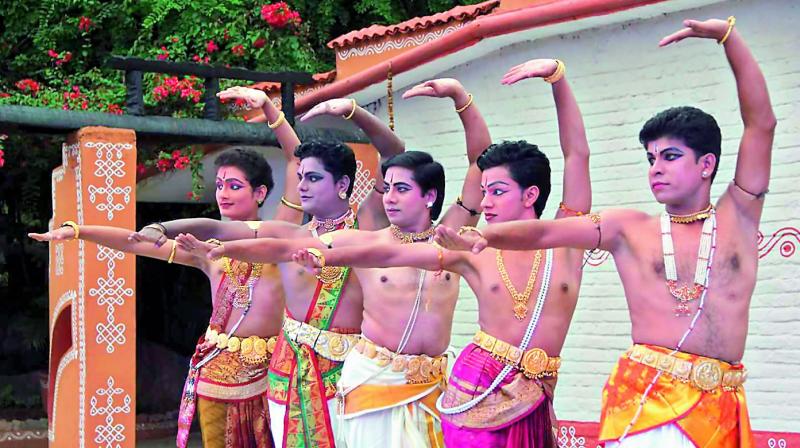Dance like a man
The opportunities to learn and perform classical dance forms for male dancers are few and far between.

Natya Anisham — The Male Dance Festival was recently organised at Shilparamam, highlighting the need to understand the historical position of men in classical dance.
Says Dr Tadepalli, Director of International Dance Research and Training Centre, “This is the second male dance festival being organised by our institute at Hyderabad. Kuchipudi Yakshagana dance has a tradition of being performed and taught by men from the time it was conceived by Siddhendra Yogi in the 17th century. It was Guru Vedantam Laxminarayana who started teaching this dance form to girl students and sadly, very few boys have come forward to keep up the tradition.”
He adds, “People forget that the real tradition was all about performances by male dancers. Young boys learning dance are not encouraged and in fact, looked down upon in society. Organisers must also provide a platform for male dancers.”
Sanjay Joshi, a Kathak dance artiste from Hyderabad, has been trained in Vilasini Natyam dance. “Male dancers hardly have any opportunity for performances. On several occasions, organisers ask how many girl dancers would be a part of the troupe and the age group of the performers. How can a stage performance be planned with all such requirements?” he asks.
Further, he shares, “For me, even learning and performing Vilasini Natyam was a difficult task. Being a female dance tradition, it took years of watching the art form from the sidelines of the Rangbagh temple festival before I finally mustered courage to ask Guru Swapna Sundari about it. Although dance has always been associated with Nataraja, today there is a perception that classical dance is more about female performers.”
Dr Bhagavatula Sethuram, son of Sri Bhagavatula Ramakotaiah (a famous proponent of Kuchipudi dance in the Telangana region) teaches Kuchipudi dance at the Potti Sreeramulu Telugu University. “An Indian male is supposed to be the breadwinner of the family, and dance offers no surety of financial support. This is why most male dancers take up this art form as their second employment or for passion. My own father initially did not encourage me whole-heartedly to learn dance. There are also less employment opportunities for male dancers,” explains Dr Sethuram.
Talking about some of the other challenges, he says, “Many institutions refuse to employ male teachers as dance faculty. There has not been a substantial increase in the number of boys coming forward to learn dance over the last few years. Those who start learning generally expect fame and monetary benefits in a short span of time.”
Pramod Reddy has been a Bharatanatyam dance performer, having learnt from Manjula Srinivas at Secunderabad Government music and dance college and later from Chitra Narayanan.
Says Pramod, “I have conducted ‘Gandharva’ male dance festival for the past three years in Hyderabad and am happy that most famous female dancers from the twin cities have attended and appreciated the efforts behind the festival. Sponsorship is very difficult but my passion keeps me going. I have two boy students and give them opportunities in most of my programmes. However, most male dancers are settling down as teachers because there is hardly any support for performances.”

